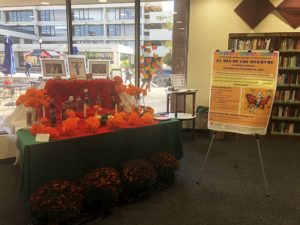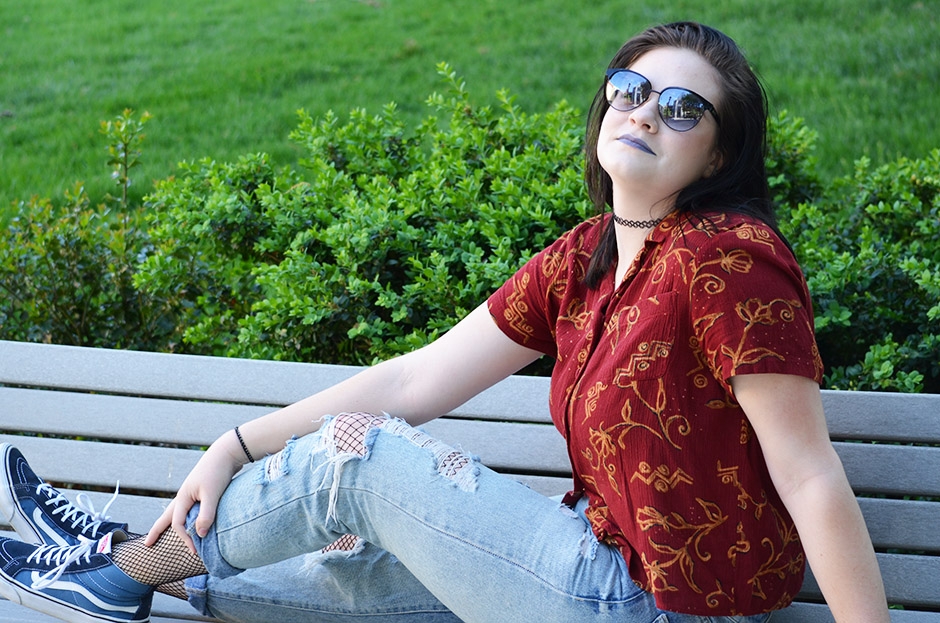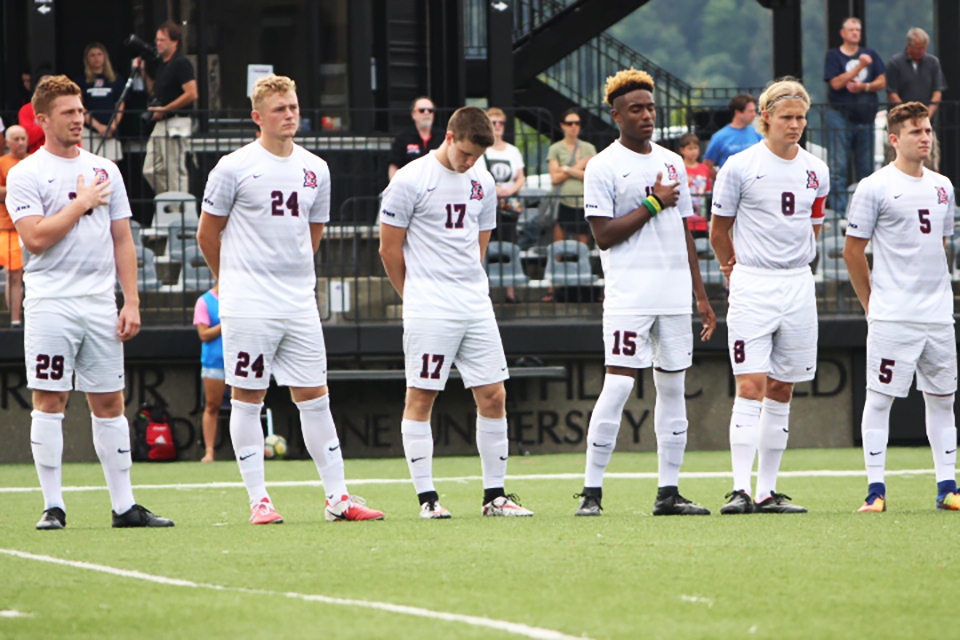
The altar in the Popular Reading Room of Gumberg Library will remain up until Nov. 12. Students are encouraged to add flowers in remembrance of loved ones.
Krystina Primack | Staff Writer
11/01/2018
Since fall 2014, Gumberg Library, the Spiritan Campus Ministry and the Department of Modern Languages and Literatures have worked together to host the annual celebration of El Día De Los Muertos, or the Day of the Dead. At the beginning of this week, this tradition of hosting the celebration continued with the opening of a display located in the library’s Popular Reading Room on the fourth floor.
Spearheaded by Mildred López Escudero of McAnulty College’s Department of Languages and Literatures, this project of observing the Day of the Dead strives to teach students about the historic and symbolic nature of the holiday itself, doing so in part by immersing them in Mexican cultural practices, or, as the Gumberg Library website states, “[by] converging the feeling of being embedded in a Latin American communal celebration with a rewarding experience of learning a new language in a relaxed and fun environment.”
Our Día De Los Muertos celebration in particular also illustrate the importance of learning why holidays are celebrated in different cultures, and how those celebrations unfold. One goal of the Department of Modern Languages and Literatures is to encourage student engagement with what is known as the five C’s in foreign language education: communication, cultures, connections, comparisons and communities.
“Our school is very diverse, but we don’t [usually] get the chance to understand other people’s cultures [and] celebrations, so I feel like being able to learn about this and do a hands-on activity about it is interesting,” Chelsea Campbell, a junior psychology major said.
The event was met with much excitement from student attendees, who noted the importance of the message that the organizers of the project hope to promote.
Similarly, Anna Radie, another junior psychology major, said of the event, “It gives us a chance to be open-minded to other peoples’ cultures as well, because we don’t really get a chance to dive in to what other people celebrate and what their holidays are actually all about, whereas this [event] gives us a chance to be involved and understand different cultures.”
This year’s Día De Los Muertos festivities began on Oct. 29 with a presentation given by López Escudero, followed by a lesson for the audience about constructing our own offerings of paper marigolds, or cempazuchitl. Afterward, the audience was invited upstairs to the popular reading room to witness and participate in the building and blessing of a communal altar, or ofrenda, which is meant to welcome the spirits of the dead back into the realm of the living.
To build the ofrenda in the library, students placed trinkets, candles and other offerings on the altar. Then, after the audience sang Alabare, a short hymn in the style of a folk song, Father Dan Walsh blessed the altar, invited the audience to speak the names of their departed loved ones to honor their memories and led a short prayer service to punctuate this year’s celebration. Mexican hot chocolate and the bread of the dead, or pan de muerto, was available to everyone attending the event as well.
Traditionally, the main objects on ofrendas are symbolic of life’s elements: water, wind, fire and earth, which are offered in containers appropriate to those elements, such as clay cups, candles, tissue paper cut-outs and food. Ofrendas may also include crosses and statues of the Blessed Virgin Mary, elaborate representations of human skulls ― sometimes referred to as alfeñique sugar skulls or calaveras ― which are meant to symbolize the vitality of the departed.
Additionally, ofrendas are often surrounded by Aztec marigolds, whose petals guide wandering souls to their living families, and then back to their final resting place. Ofrendas might also have toys for the spirits of departed children, favorite foods and beverages, photographs and other small personal possessions of loved ones. All of these offerings serve to welcome the deceased home and to aid them on their long journey from this world to the next.
When an altar is put together in a private home, the family members of that household come together to tell stories about their deceased loved ones, where each person must contribute in some way to the storytelling process, usually in the form of humorous anecdotes or poems. This practice promotes the connectedness of the family, both living and dead, and shows reverence for the dead as their family celebrates their life rather than mourning their passing.
This practice stems, in part, from the cultural idea that death is a natural part of life, and that the dead are still members of their communities. Therefore, it is considered highly disrespectful to mourn for them. Instead, family members and friends are encouraged to keep their memories alive through stories and offerings, thus allowing their lives to continue in the communities and to give the dead the opportunity to temporarily return.
The ofrenda in Gumberg Library honors Anthony Bourdain, world traveler & culinary expert (viajero y experto culinario), Aretha Franklin, the Queen of Soul (la reina de la música soul), and Mac Miller, Pittsburgh rapper (rapero de Pittsburgh). Duquesne students are also invited to add flowers, paper butterflies and other offerings to their own departed loved ones.
The altar will remain in the reading room through Nov. 12.
Contrary to popular belief, the Day of the Dead is not merely a Mexican version of Halloween. Much like Nigeria’s Odo Masquerade Festival, China’s Hungry Ghost Festival or even the modern practice of holding celebrations in the Romanian city of Brasov at Bran Castle ― made famous Bram Stoker as Dracula’s Castle ― the Day of the Dead and Halloween differ greatly from one another in their meaning and traditions. Halloween in the U.S. tends to focus more on darkness and fear, whereas celebrations of the Day of the Dead focus on color, life-affirming joy and memorializing departed friends and family members in a respectful and vibrant way.
Although the holiday was unknown in northern regions of Mexico until the 20th century and initially rejected for its pagan elements, it is now a unifying national tradition. It has also become well-known and celebrated in several other countries including Peru, Ecuador, Bolivia, Guatemala and, of course, the U.S.
Beginning as an ancient Aztec festival dedicated to the goddess Mictecacihuatl, the queen of the underworld, the basic principles of the holiday go back 2,500 to 3,000 years. Originally, El Día De Los Muertos was observed in early August and lasted into early September. It was celebrated in Central and Southern Mexico for the majority of its existence, but after Spanish colonization took place in the 16th century, the Day of the Dead gradually came to be observed later in the fall, eventually becoming more closely related to what we know as modern Christianity’s Oct. 31, Nov. 1 and Nov. 2 observances of All Saints’ Eve, All Saints’ Day and All Souls’ Day, respectively.
In an anthropological phenomenon known as religious syncretism, the Christian and ancient Aztec traditions melded into one, and thereafter, children began to decorate their altars on Oct. 31 to invite the spirits of departed children to return, a day that is referred to as the Day of the Innocents, or Día de los Inocentes, but also as the Day of the Little Angels, or Día de los Angelitos. After the Day of the Little Angels, adult spirits are able to return to the world of the living as well, their arrival taking place on Nov. 1. Then, on Nov. 2, families travel to local cemeteries to celebrate the lives of their departed loved ones at their graves.
In 2008, UNESCO added the “indigenous festivity dedicated to the dead” to its list of Intangible Cultural Heritage. It was the first cultural practice from Mexico to be recognized as such, and played a significant role in bringing The Day of the Dead further into cultures outside of Mexico.
The Day of the Dead that we’re probably the most familiar with emerged during the Chicano Movement of the 1990s through the early 2000s, and has become part of the diverse cultural background of the U.S. ever since. In the U.S., especially the southern states bordering Mexico, The Day of the Dead is widely celebrated in ways that are very close to traditional celebrations.
For example, Santa Ana, California is said to hold “the largest event in Southern California,” called the annual Night of Altars, or Noche de Altares. Similarly, in Los Angeles, the Self Help Graphics & Art Mexican-American Cultural Center presents Day of the Dead celebrations that include both traditional and political elements, such as altars to honor the victims of the Iraq War, highlighting the high casualty rate among Latino soldiers.
However, Day of the Dead celebrations are observed beyond southern states as well, such as a yearly festival held at the historic Forest Hills Cemetery in Boston’s Jamaica Plain neighborhood, and events in Missoula, Montana, where celebrants wearing skeleton costumes walk on stilts and ride novelty bicycles through town. On Nov. 1 and 2, Pittsburgh itself will be hosting an event called the Festival of the Skull, or Festival La Calaca, which will include parades, dinners and altars set up outside San Miguel the Archangel parish church.
The Smithsonian Institution has created the Smithsonian Latino Virtual Museum and multimedia ebook entitled Día de los Muertos: Day of the Dead. Details about this and other informative texts can be found on the Gumberg Library website’s page about this year’s Day of the Dead festivities.
Losing someone we knew and loved can be one of the most difficult experiences a person can go through. Sadly, no one is exempt from this aspect of life, and unfortunately, our community at this university and surrounding neighborhoods have gone through so much loss recently. But while it’s important to mourn properly and to seek help and support through that time of mourning, it is also important to remember those whom we have lost and to honor them by living well. By participating in the Day of the Dead events, we can begin to do just that for those that meant so much to us.
Although The Day of the Dead is still very much evolving and adapting to the ever-changing globalized world, the holiday itself remains a crucial practice of respecting the dead, celebrating life and committing to one’s community.




